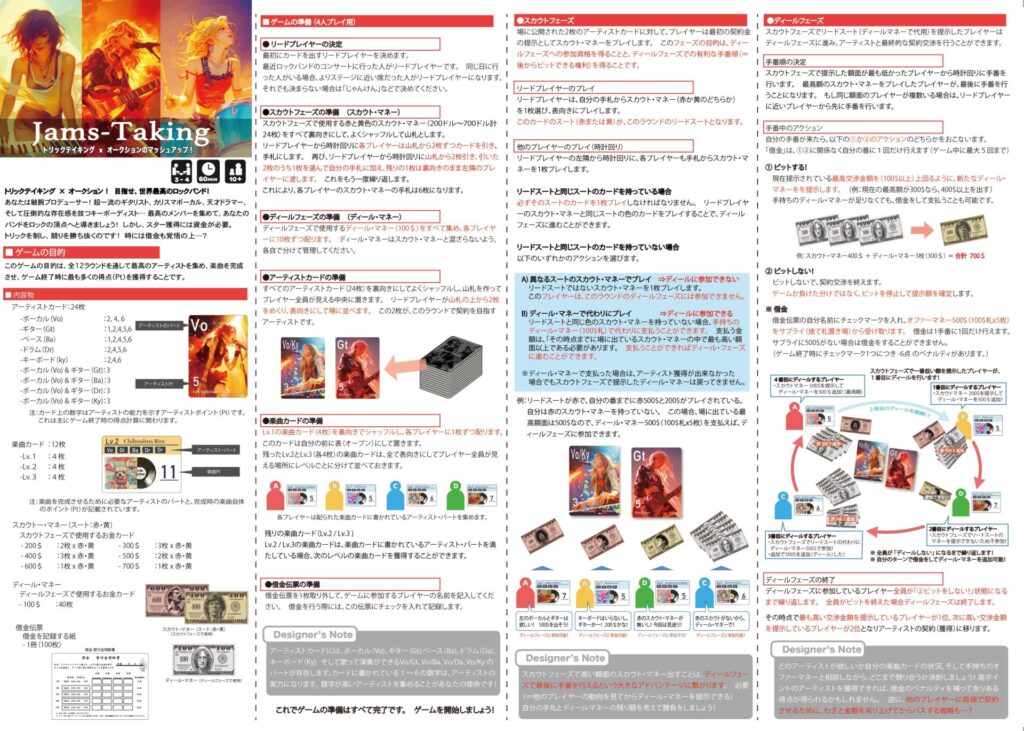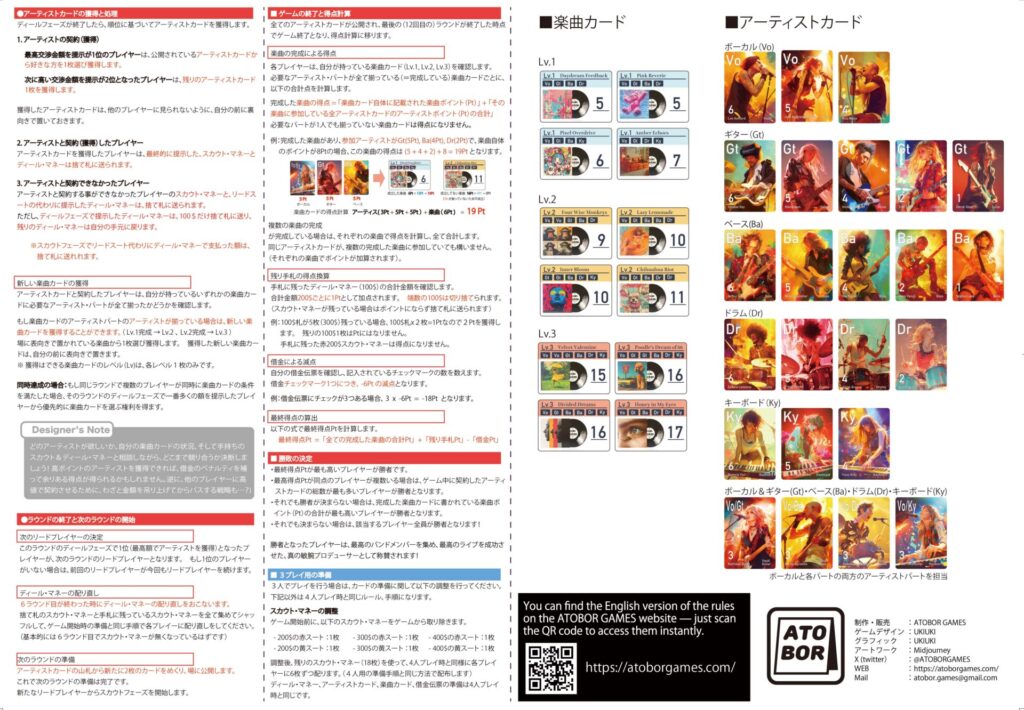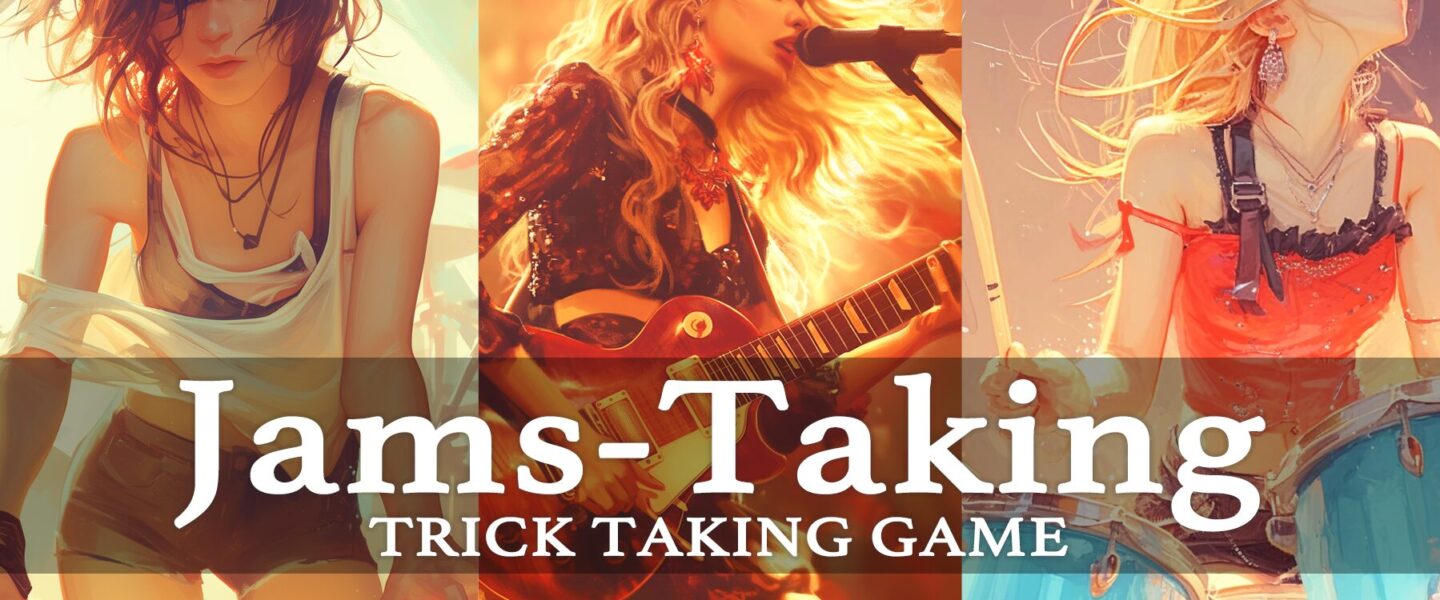Trick-taking × Auction! Aim for the World’s Best Rock Band!

You are a shrewd producer! A top-tier guitarist, a charismatic vocalist, a genius drummer, and a keyboardist with an overwhelming stage presence… Gather the best members and lead your band to the pinnacle of rock! However, acquiring stars costs money. Dominate the tricks and win the auctions! Rack up debt and make it rain with wads of cash! Debt? Bring it on!
The goal of the game is to gather the best artists over 12 rounds, complete songs, and earn the most points (Pt) by the end of the game.
After the “Scout Phase” comes the “Raise Phase,” where the top two players who bid the highest amounts can sign artists. Produce by gathering talented artists so they can perform your songs!
■ Contents
Artist Cards
-Vocal (Vo): 2, 4, 6
-Guitar (Gt): 1, 2, 4, 5, 6
-Bass (Ba): 1, 2, 4, 5, 6
-Drums (Dr): 2, 4, 5, 6
-Keyboard (Ky): 2, 4, 6
-Vocal (Vo) & Guitar (Gt): 3
-Vocal (Vo) & Bass (Ba): 3
-Vocal (Vo) & Drums (Dr): 3
-Vocal (Vo) & Keyboard (Ky): 3
Note: The number on the card indicates the artist’s ability as Artist Points (Pt).

Song Cards
-Lv. 1: 4 cards
-Lv. 2: 4 cards
-Lv. 3: 4 cards
Note: These cards show the artist parts needed to complete the song and the song’s own points (Pt) when completed.
Scout Money (Suits: Red, Yellow)
-$200: 2 cards x Red & Yellow
-$300: 3 cards x Red & Yellow
-$400: 3 cards x Red & Yellow
-$500: 2 cards x Red & Yellow
-$600: 1 card x Red & Yellow
-$700: 1 card x Red & Yellow

Raise Money
Money cards used in the Raise Phase.
$100: 40 cards
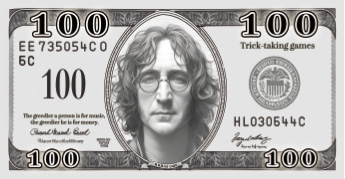
Debt Slips
Paper for recording debt.
1 pad (100 sheets)
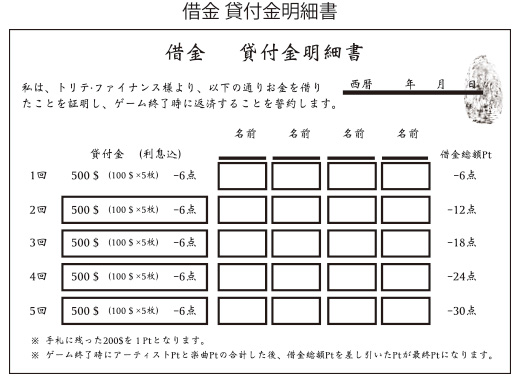
■ Game Setup (For 4 Players)
Decide the lead player who will play the first card. The person who most recently attended a rock band concert is the lead player. If multiple people went on the same day, the person who had the seat closest to the stage is the lead player. If still undecided, use rock-paper-scissors or a similar method.
● Scout Phase Setup (Scout Money)
Take all Red and Yellow Scout Money cards ($200 to $700, 24 cards total), shuffle them face down to form a draw pile. Starting with the lead player and going clockwise, each player draws 2 cards from the draw pile into their hand. Again, starting with the lead player and going clockwise, each player draws 2 cards. They choose 1 to add to their hand and pass the other face down to the player on their left. Repeat this process once more. Each player will now have 6 Scout Money cards in their hand.
● Raise Phase Setup (Raise Money)
Gather all Raise Money cards ($100) and deal 10 to each player.
Keep Raise Money separate from Scout Money.
● Artist Card Setup
Shuffle all 24 Artist cards face down to create a draw pile and place it in the center, visible to all players. The lead player flips over the top 2 cards from the draw pile and places them face up in the play area.
These are the two artists available to be signed this round. The player who bids the highest amount gets first pick of these two, and the player with the second-highest bid signs the remaining artist.

● Song Card Setup
Shuffle the 4 Lv. 1 Song cards face down and deal one to each player. Players place this card face up in front of them. Keep the remaining Lv. 2 and Lv. 3 Song cards (4 of each) in separate piles by level. Players can look at the Song cards at any time to check the required artist parts.

Remaining Song Cards (Lv. 2 / Lv. 3)
If a player fulfills the artist part requirements on their current Song card, they can acquire a Song card of the next level (Lv. 2 or Lv. 3).
● Setting up a debt voucher
Prepare the Debt Slip pad. Players will use it to record their debts. When taking a debt, players will mark it on a slip.
Designer’s Notes
Artist cards include parts for Vocal (Vo), Guitar (Gt), Bass (Ba), Drums (Dr), Keyboard (Ky), and also multi-role artists like Vo/Gt, Vo/Ba, Vo/Dr, Vo/Ky. The numbers 1-6 on the cards represent the artist’s skill level. Your goal is to gather artists with high numbers!
● Scout Phas
For the 2 Artist cards revealed in the play area, players will play Scout Money as an initial bid. The purpose of this phase is to qualify for the Raise Phase and to gain a favorable turn order in it.
▼ Only Two Artists Can Be Signed!
The two players who have bid the highest total amounts across the Scout and Raise Phases can sign (acquire) an artist.
▼ Lead Player’s Play
The lead player chooses one Scout Money card (either Red or Yellow) from their hand and plays it face up.
The suit of this card (Red or Yellow) becomes the lead suit for this round.
▼ Other Players’ Play (Clockwise)
Starting from the player to the left of the lead player and going clockwise, each player also plays one Scout Money card from their hand.
▼ If You Have Scout Money of the Lead Suit
You must play one card of the same suit. By playing a card of the same suit as the lead player’s Scout Money, you can proceed to the Raise Phase. The amount played can be any value.
▼ If You Do Not Have Scout Money of the Lead Suit Choose one of the following actions:
A) Play Scout Money of a Different Suit ⇒ Cannot participate in the Raise Phase Play one Scout Money card that is not of the lead suit. This player cannot participate in this round’s Raise Phase.
B) Substitute with Raise Money ⇒ Can participate in the Raise Phase If you don’t have Scout Money of the lead suit, you can pay $200 from your Raise Money (two $100 bills) to substitute for it. You cannot do this if you do not have two $100 bills. (Paid Raise Money is sent to the discard pile even if you don’t sign an artist.)
Example of Scout Phase
The available artists are a Vocal/Keyboard (3Pt) and a Guitar (5Pt). Player A wants Vo, Gt, and Vo parts, so they bid Red: $500! Player B only needs Vo and Gt, so they aim for 2nd place with Red: $300. Player C doesn’t have a Red suit card, so they play a Yellow suit card and drop out of the bidding for artists this round. Player D also doesn’t have the lead suit but wants Vo, Gt, and Vo parts, so they pay Raise Money to participate in the Raise Phase, hoping to win a contract!

Designer’s Notes
Playing a high-value Scout Money card in the Scout Phase gives you a significant advantage: you get to act last in the Raise Phase. This allows you to see other players’ moves before bidding your Raise Money, giving you a tactical edge.
Even if you don’t have the lead suit, you can substitute with Raise Money.
For artists you desperately want, it might be better to take on debt to acquire them…
● Raise Phase
Players who played the lead suit (or substituted with Raise Money) in the Scout Phase proceed to the Raise Phase to conduct final contract negotiations with the artists.
▼ Determining Turn Order
Turn order proceeds clockwise, starting with the player who bid the lowest value on their Scout Money card in the Scout Phase. The player who played the highest value Scout Money card will go last. If multiple players bid the same amount, the player closest to the lead player (in clockwise order from the lead player) goes first among them.
▼ Actions During Your Turn
When it’s your turn, perform one of the following actions (① or ②):
“Debt” can be taken any number of times on your turn, regardless of choosing ① or ② (up to a game maximum of 5 times).
① Raise!
Add Raise Money to the Scout Money you’ve already bid. You can add any amount of Raise Money you possess. It’s possible to take a debt to pay for this.

Note: You don’t have to raise to the highest bid. Since you can acquire an artist even in 2nd place, bidding an amount aiming for 2nd place is a valid strategy! In case of a tie for bid amount, the player closer to the lead player is considered higher ranked (for 1st or 2nd place).
Note: Debt When you take a debt, put a checkmark by your name on a Debt Slip and receive $500 in Raise Money (five $100 bills) from the supply (if $500 is available in the supply!). Each debt taken results in -6 points. You can take a debt multiple times during your turn in the Scout & Raise phase, but only up to a maximum of 5 times per game.
② Do Not Raise! (Pass)
If you choose not to raise (pass), you cannot raise again for the remainder of this round.
※ Debt
When you place a check mark on the name of a Debt Slip, you receive Raise Money of $500 (5 × $100 bills) from the supply (discard pile)—if the supply has $500 available!
Each instance of taking debt results in “-6 points.”
You may take debt as many times as you like during your own Scout & Raise Phase, but only up to a maximum of 5 times in total.
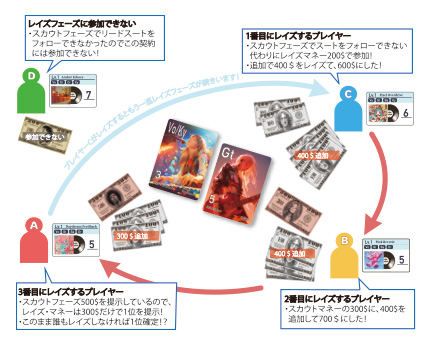
End of the Raise Phase
The Raise Phase continues until all participating players choose “② Do Not Raise!” (pass). Once all players have finished raising (or passed), the Raise Phase ends.
At that point, the player with the highest total bid (Scout Money + Raise Money) is 1st, and the player with the second-highest total bid is 2nd. They proceed to sign (acquire) artists.
Designer’s Notes
When raising, consider which of the two available artists you need. The two players with the highest total bids (Scout Money + Raise Money) can sign artists. It’s perfectly fine to deliberately bid an amount aiming for 2nd place! A smart contracting strategy involves watching other players’ finances while making your raises. Try to win contracts for the lowest possible amount!
● Artist Card Contract
Once the Raise Phase ends, players sign artists based on their rank.
▼ Signing (Acquiring) Artists
- The player who bid the highest total amount (1st place) chooses one of the revealed Artist cards and signs (acquires) it.
- The player who bid the second-highest total amount (2nd place) signs (acquires) the remaining Artist card.
Note: Place acquired Artist cards face down in front of you.
Note: If only one player proceeded from the Scout Phase to the Raise Phase, that player signs (acquires) one artist, and the other is sent to the discard pile.
Note: If there are multiple players tied for the highest bid (1st place), or for the second-highest bid (2nd place), the player closest to the current round’s lead player (in clockwise order) within each tied rank wins the tie and signs (acquires) the artist.
◯ Money Processing for Players Who Signed (Acquired) an Artist
Players who signed an artist send their total bid (played Scout Money and any added Raise Money) to the discard pile.
Note: Raise Money paid as a substitute for the lead suit in the Scout Phase is also sent to the discard pile.
× Money Processing for Players Who Did Not Sign an Artist
Players who did not sign an artist send their played Scout Money and any Raise Money paid as a substitute for the lead suit (in the Scout Phase) to the discard pile.
However, for Raise Money bid during the Raise Phase, only $100 is sent to the discard pile, and the rest of that Raise Money is returned to their hand.
Acquiring New Song Cards
Players who signed an artist check if they have now gathered all the required artist parts for their current Song card.
If all artist parts for the Song card are met, they can acquire a new Song card. (e.g., Lv. 1 complete → take Lv. 2; Lv. 2 complete → take Lv. 3). Choose one new Song card of the appropriate level and place it face up in front of you.
If, upon acquiring a new Song card, you immediately meet its requirements as well, you may consecutively choose and acquire the next level Song card.
Only your highest-level completed Song card will be scored at the end of the game. If you take a higher-level Song card but fail to complete it by game end, you will score for the previously completed lower-level Song card instead.
Simultaneous Completion: If multiple players complete their Song cards in the same round, the player closest to the current round’s lead player (in clockwise order) gets to choose their new Song card first.
Designer’s Notes
Think carefully about which artist you want, the status of your own Song cards, and how much Scout & Deal Money you have, then decide how far you’re willing to go in the bidding!
If you manage to sign a high-point artist, you might earn enough points to more than make up for the debt penalty.
On the other hand, you could also drive up the price on purpose and then pass, forcing other players to sign them at a high cost…?
Determining the Next Lead Player
The player who acquired an artist with the highest bid (1st place) becomes the lead player for the next round. If there was no 1st place player (e.g., only one bidder, or no successful bids), the previous lead player continues as lead player.
Redistribute Scout Money
At the end of the 6th round, redistribute Scout Money. Collect all Scout Money from the discard pile and any remaining in players’ hands. Shuffle them all together and redistribute them to each player following the same procedure as in the initial game setup (each player gets 6 cards).
(Normally, Scout Money should be mostly used up by the 6th round.) Raise Money is not redistributed; players keep their current Raise Money.
Preparing for the Next Round
Flip over 2 new cards from the Artist card draw pile and reveal them to the play area. Start the Scout Phase with the new lead player.
■ End of Game and Scoring
The game ends when all Artist cards have been revealed and the final (12th) round is completed. Proceed to score calculation.
▼ Scoring for Completed Songs
Each player checks their highest-level completed Song card. Only the highest-level Song card for which all required artist parts have been gathered is used for scoring. Uncompleted Song cards are discarded and score no points.
Score for a completed song = [Song Points (Pt) printed on the Song card] + [Total Artist Points (Pt) of all Artist cards participating in that song].
(Song cards with even one missing required part score no points.)
▼ Example: A player has a completed song.
The participating artists are Vo/Ky (3Pt) + Gt (5Pt) + Ba (5Pt) for a total of 13 Artist Pt. Their Lv. 1 Song requirements are met, granting them, for instance, 6 Song Pt. Their Lv. 2 song is not completed.
▼ Completing Multiple Songs
If multiple Song cards are completed, only the highest-level one is scored. Example: If both Lv. 1 and Lv. 2 songs are completed, you score for the Lv. 2 song.
■ Scoring Remaining Hand Money
Raise Money remaining in hand is converted to Pt. For every $200 of Raise Money, 1 Pt is added. Any remaining $100 is rounded down (worth 0 Pt).
(Scout Money remaining in hand does not score points.)
Example: If you have 5 Raise Money cards ($500) left, $200 = 1 Pt, so you get 2 Pt (from $400). The remaining one $100 bill is not worth any Pt.
Debt Deduction Check your Debt Slip and count the number of checkmarks you’ve made. Each debt checkmark is a deduction of -6 Pt. Example: If there are 3 checkmarks on your Debt Slip, 3 x -6 Pt = -18 Pt.
Final Score Calculation Calculate the final Pt score using the following formula: Final Score (Pt) = [Total Pt from your highest Completed Song] + [Remaining Hand Money Pt] – [Debt Pt]
The player with the highest final Pt score is the winner.
If multiple players are tied for the highest Pt, the player among them who signed the most Artist cards during the game is the winner. If still tied, all tied players are winners!
The winning player is lauded as a true shrewd producer who assembled the best band members and put on the greatest live show!
■ 3-Player Setup
When playing with 3 players, make the following adjustments to card setup.
Other than the adjustments below, the rules and procedures are the same as for a 4-player game.
Scout Money Adjustment
Before starting the game, remove the following Scout Money cards from the game:
-Red Suit $200: 1 card
-Red Suit $300: 1 card
-Red Suit $400: 1 card
-Yellow Suit $200: 1 card
-Yellow Suit $300: 1 card
-Yellow Suit $400: 1 card
Raise Money Adjustment
Deal 13 Raise Money cards ($100 each) to each player. Place the one leftover $100 card in the discard pile.
The remaining Scout Money (18 cards) is dealt so that each player gets 6, following the same procedure as in a 4-player game.
The setup for Artist cards, Song cards, and Debt Slips is the same as for a 4-player game.

The original rulebook of the Japanese language board
